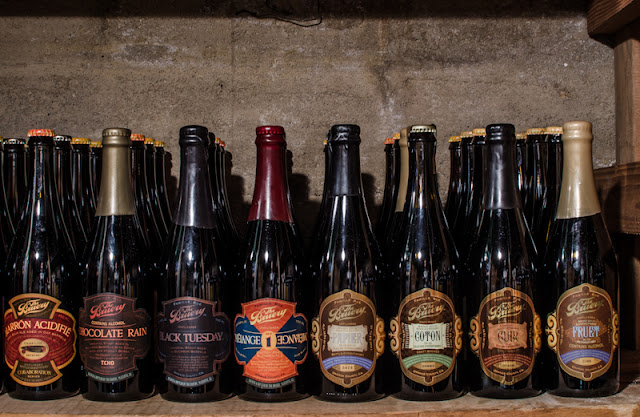Cellarmanship Part 2: How To Store Your Hoarded Beer Properly
Welcome to the third installment of
, a series where we talk about the how-to, the joys, and details of cellaring your beer at home. In
we introduced you to the topic and explained why we find joy in doing it. Next we
interviewed Eric and Lauren Salazar
of New Belgium for their opinions and guidance on storing beer at home. With this post we would like to dive into some of the how-to of the matter.
is about picking the right beer.
Intro:
Perhaps by now you're convinced to stash a bottle of beer or two away. Where will you keep it? What do you do with this beer? Do you make a time capsule and bury it under the sidewalk of your kid's elementary school? Storing beer properly is probably the most crucial step of cellaring beer bottles once you've decided what you want to age. It can mean the difference between opening a 5 year old beer and having your taste buds cry with joy or giving it a nice pour down the drain. Nothing like buying a beer, setting it aside, resisting the temptations to drink it over and over again, rocking it to sleep every night, and then when the occasion comes you crack it open and it's gross. There are some things you have to do to age beer properly. Then, there are things you can do that are more of a choice and open for debate.

You know, aging beer in your cellar is already a pretty arguable topic in the first place. There are always brewers voicing their opinion against cellaring beer and arguing that the brewer has given that beer to you at it's peak; almost insulted you would do anything else with it. On the other hand, we hear the opposite from other brewers making as some make verticals that you are supposed to collect over a few years. We are continuously opening 2-10 year old beers and being absolutely mind fucked by how great they are.I'm not saying any beer will do great even in the most-of perfect conditions, but the best cellaring candidate can be trashed because of horrible living conditions. The next article in our series will dive into what styles, ABVs, and other considerations there are to consider for aging. I want to be clear. I'm not talking about saving a normal wheat beer, IPA, or beers that will obviously degrade over time. I thought it would be nice to talk about storage conditions first so that's what I'm doing in this article. That way if you decide to jump on this Cellarmanship hype train you can have a perfect little home carved away and waiting for that beer after the next article.
The Laws:
There are some rules that I would consider Laws for Aging Beer and there are also some rules that are choices; decisions you'll have to make from experience or external input. I'll try to make it clear which ones I'm talking about and when.
Lighting
Sunlight is the devil…when talking about beer (or gingers for that matter). There are some things that can spoil beer that at other times play a very important role in the beer making process. Sunlight is not one of them. That really makes this law of beer storing easy. Keep your beer out of the sun. The most common effect of sunlight is "skunking" a beer. UV rays break down hop compounds and produce the same chemical found in skunk farts, hence the name. This could give you some guidance of what type of lights you want to use to shine down on your beer when in your cellar. If possible, avoid UV type lights. However in my opinion, a light won't necessarily be a deal breaker but the sun definitely is. The amount of UV coming from a light and the time/frequency is very little in comparison.
Temperature
Temperature will most likely be the biggest hurdle for starting a cellar. High heat conditions are automatically a no-go. Heat can cause certain bacteria in wild ales to run well, wild. Certain bacteria that usually blends and plays nice with the others will turn and eventually dominate. Heat can also kill yeast. If you're storing bottle-conditioned beers, then you'll destroy the living product. Heat can break down compounds in beer, basically unblending them to a degree and causing off-favors. Something else to consider is heat fluctuation. Swings in temperature will allow the air in the bottle to expand or contract causing product to be pushed out or oxygen to be drawn in.Temperature fluctuation is actually the "Holy Grail" in wine storage. I kinda thought the expanding-and-contracting-air-thing was silly until I researched wine storage more. Over and over again, this was one of the most emphasized points. They recommend no more than a five degree temperature swing over a year. A good temperature range is 50-60 degrees. My cellar goes from 55 ish to 62 ish over the course of a year. Since my cellar is in my basement surrounded by foundation on three sides, fluctuation is not a concern. I seem to get a max of a degree or two here and there. So in summation you're looking for somewhere 50-60 degrees that stays really constant and takes a long time to change temperatures. Daily temperature swings would not be ideal. If they're pretty minor and that's what you got, then it sounds like its time to experiment.
Alternatives
Don't let all these things dissuade you quite yet though. There are options and compromises. Maybe you have space in your fridge for a couple special bottles tucked away in the back where you can forget about them. Maybe you have a spare fridge in the garage; a mini fridge stashed in the basement. You could even buy an upright freezer and a temperature controller that shuts the freezer on and off, keeping the temperature constant. Stash a box or two in the corner of the basement on the floor (you'd be surprised how well that can regulate temps). People are storing beer everywhere and definitely fudging the temperature guidelines with great results. I'd say if you have less than perfect temperature control, it still might be worth trying, just be prepared.This info can get a little dry and start to turn you off if you don't think you have the perfect conditions. Take a breather. Check out this post on beeradvocate.com. Be warned though, the nerdiness gets pretty thick on this post. It's pictures of people's cellars. A lot of these aren't perfect and some are too perfect. Either way both are working to some degree. (Check out page 9 under D4radio, that guy is a total nerd).
Oxygenation
Oxygen is another crucial player in the brewing process for fermentation and healthy yeast, but a real beer killer at the wrong times. Oxygenation can lead to wet cardboard like flavors, yum! This is something I feel you have very little control over. Its not like you can suck all the oxygen out of your cellar. I've found that if oxygenation is a real problem in a beer and it was stored in decent conditions; then it seems the real problem started when it was bottled. Also bottle caps aren't perfect, they can let oxygen seep in over time. This can be a real long time if the beer is properly stored and was properly packaged. Even after oxygen very slowly creeps into properly stored, non-wild, heavy beer, it can lead to port, leathery, nutty, and other flavors. The effects of oxygen seem to be more pronounced on smaller and less malty beers, ruining them quite quickly. That damn Acetobacter, which is an acetic acid bacteria that converts ethanol to acetic acid (vinegar), is common in many sour-style beers and it seeks out oxygen too. It's usually kept in check by lack of oxygen, but if it finds any it can turn a sour beer straight into vinegar.
Bottles of Cantillon stored on their side
The only beers you might have any input on, in terms of limiting oxygenation at all, seem to be bottles that are corked (and no one is really sure that you truly do have input here either). This is probably the most debated topic inside the nerdiest of the nerd cellaring community. Should you store corked beers on their side, like wine, or store them upright? I've chosen to store my sours/wilds that are corked on their side and my normal corked beers upright. I've based my decision on information from Lambic and Gueuze producers, the wine industry, experiences, length of planned storage, and fear of that damn Acetobacter getting fed by oxygen sneaking past a dried out cork. Is the way I do it right? Of course it is, but does it matter? I don't think it does a whole lot. This is a giant argument with both sides well represented. Lauren Salazar mentioned storing bottles on their side in our interview with her as a way to help storage. I don't feel it necessary to get into this all here as this is just an introduction. There is tons of information on this debate, check out the two nerdy beer sites differing opinions here.
Organization
I think there are only a couple more things to consider if you choose to cellar. The most important, if your cellar continues to grow, is organization. I don't mean you need to keep your bottles alphabetical or color coded by label or anything like that, but being able to reference what you have is very convenient. I use cellarhq.com. Here's my cellar. This site can be a useful tool for beer shopping, trading beer, or making sure you don't drink the last of something you were meaning to save. If you plan on getting the same beer but different vintages make sure the label differentiates itself between years or you'll need to mark them yourself. A couple of other things include humidity and security. If you plan on storing in a fridge over an extended period of time, be aware of cork shrinkage as fridges get pretty dry and can cause the cork to shrink. Lastly security; I can't say I'm worried about someone robbing me and stealing my beer. That is besides me. One of the worst feelings is getting a little sloppy at your own house and waking up to a counter full of beers from your cellar you don't remember drinking. If you plan on getting silly, get the bottles out before hand, lock it and give someone else the key.
Quick Summary and Tips:
Cellaring beer is fun, once you find a good place to store it away. It can really lead to some great tasting experiences. Here's my quick list of how to cellar.
Choose the proper beers to cellar (This will be the topic of our next article)
Buy at least 2 and taste one fresh
Have a goal for the beer you put away (ie. Verticals - the same beer once a year to see how it changes. Or cellar a special beer with an idea of how long you'd like to age it.)
No sun
Temp between 50-60 ish
In a space that limits temperature fluctuations
Capped beer upright, corked normal beer upright, and corked sour/wild beer on it's side (the last one is a personal preference)
Keep track of it somehow (what you have, how many you have, and vintages)
Experiment, share, and nerd out to the fullest extent possible
Thanks to Scott Simmons for the article! You can keep up with his exploits on his Instagram page.- - -Check out Part 3, where we talk about what beers you should pick to age.





